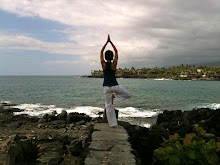This is a very common yoga sequence and repeated frequently in the session that I do. I mentioned in my earlier post that I haven't noticed as much strength and toning on my abs. So, as I wondered why, I came across a video by Duncan Peak.
Duncan Peak is the founder of Power Living Australia and although I've not attended any of their classes (I hear they are tough!) this guy inspires me with his views on yogic living, the discipline he seems to apply to himself, his flexibility and his strength (note: fantastic body).
It's always good to check out yourself in the mirror at times to see if your alignment is right. I try to make sure I get a spot right next to a mirror so I can ensure my postures are correct (and part vanity).
As I studied Duncan's moves in this video, I realised I don't push my shoulders back enough and my elbows start to splay out a little when I'm moving from dandasana (plank) to chaturanga dandasana (low push up). At times I also start sagging the hips when I'm tired because I don't have the strength. This is easily fixed though by doing a variation with your knees on the mat.
Also, from Chaturanga dandasana (low push up) to Urdhva Mukha Svanasana (upward facing dog), I tend to hold tension on my shoulders and forget to push them back away from the neck. This could be the reason why I feel tight there after a yoga session.
Must remember to pull the shoulders back and tighten the stomach muscles to protect the lower back! Not to mention tight abs!
Duncan Peak's plank to upward dog
Duncan Peak is the founder of Power Living Australia and although I've not attended any of their classes (I hear they are tough!) this guy inspires me with his views on yogic living, the discipline he seems to apply to himself, his flexibility and his strength (note: fantastic body).
It's always good to check out yourself in the mirror at times to see if your alignment is right. I try to make sure I get a spot right next to a mirror so I can ensure my postures are correct (and part vanity).
As I studied Duncan's moves in this video, I realised I don't push my shoulders back enough and my elbows start to splay out a little when I'm moving from dandasana (plank) to chaturanga dandasana (low push up). At times I also start sagging the hips when I'm tired because I don't have the strength. This is easily fixed though by doing a variation with your knees on the mat.
Also, from Chaturanga dandasana (low push up) to Urdhva Mukha Svanasana (upward facing dog), I tend to hold tension on my shoulders and forget to push them back away from the neck. This could be the reason why I feel tight there after a yoga session.
Must remember to pull the shoulders back and tighten the stomach muscles to protect the lower back! Not to mention tight abs!
Duncan Peak's plank to upward dog
